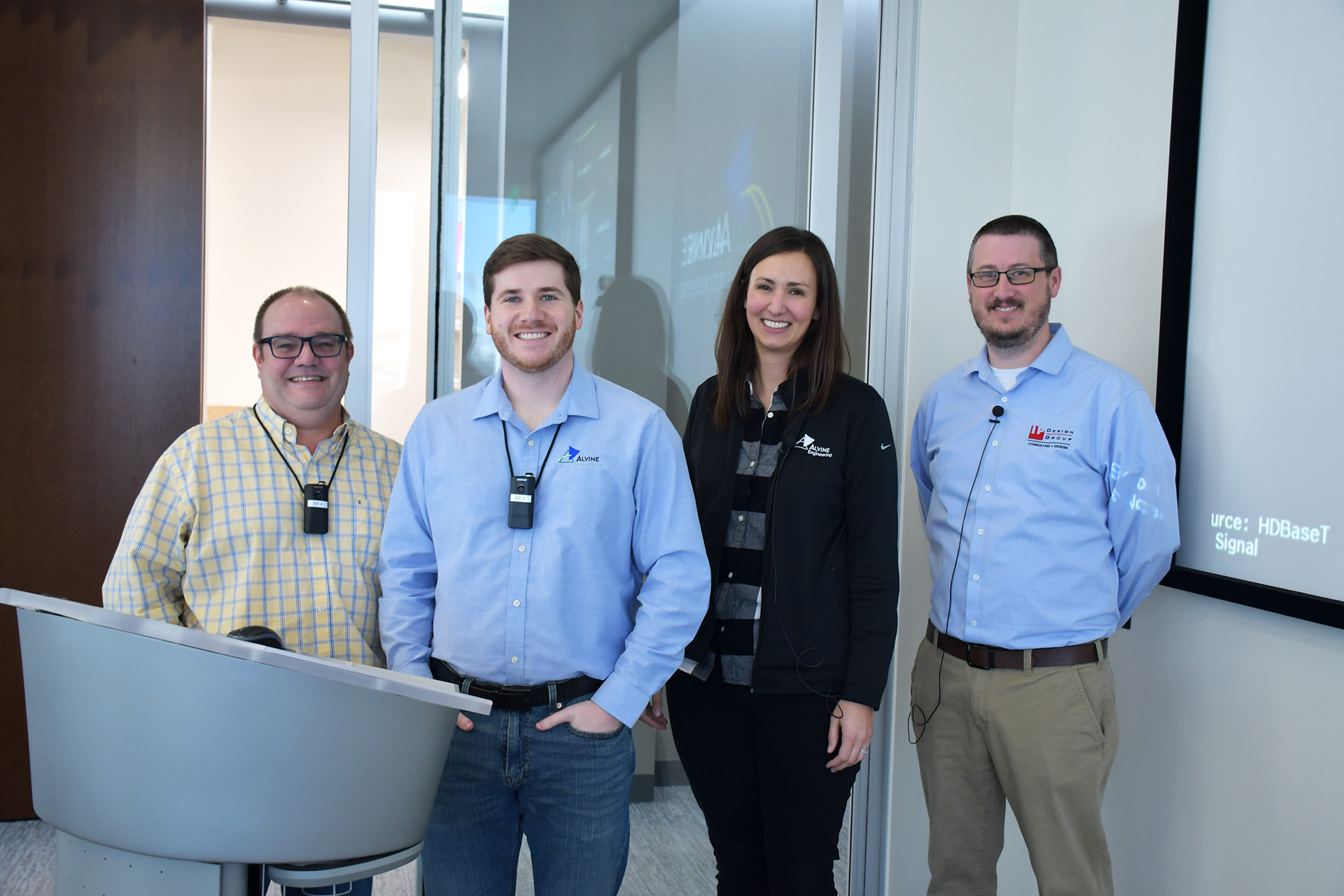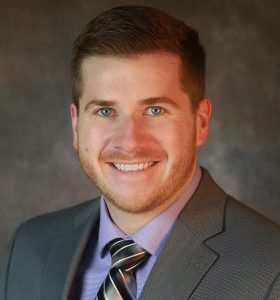MEPT Engineering 101

Last week, Gary Lange, Jacob Bullock, Mary Wurst, and Jacob Butler gave a presentation on MEPT Engineering 101 to Alvine Engineering and IP Design Group staff. The team broke down what MEPT (mechanical, electrical, plumbing, and technology) engineering is and how each discipline works with the others to make a cohesive building that runs safely and efficiently.
Why would an MEPT engineering firm benefit from an MEPT Engineering 101 presentation? It can be easy for employees to focus on their specific disciplines and not know anything about what their colleagues do. However, by learning more about each discipline, our employees can better design integrated engineering solutions.
An MEPT Engineering Overview
Alvine Engineering and IP Design Group provide many services, so Gary Lange, an associate principal, kicked things off by giving an overview of these services and the ways in which the two brands stay up-to-date on the latest advancements within the architecture, engineering, and construction industry. A high-level view of MEPT systems stressed coordination and collaboration with each of the other disciplines, as well as the architect and structural engineer. Lange also explained the importance of identifying goals, such as Net Zero, early in design so that all disciplines can work together to achieve those goals.
Key Tips
- Alvine Engineering provides mechanical, electrical, plumbing, and fire protection engineering, as well as architectural lighting and foodservice consulting and design
- IP Design Group provides planning and assessments, design, procurement, construction administration, telecommunications, electronic security and video surveillance, acoustical consulting, and audiovisual services
- Across the firm, staff have a combined 20 different licenses and certifications
Key Tips
- Look for ways to increase energy efficiency
- Address remaining needs with on-site renewable energy generation such as wind, solar, or hydro power

Jacob Bullock focuses on projects involving K-12 and higher education buildings, as well as many local Omaha projects. While usually smaller in scale, these projects provide him with diverse opportunities and challenges. One of his favorite projects required overcoming unique challenges to create a photo kitchen for Omaha Steaks to film and photograph completed dishes for marketing materials.
Mechanical Engineering
Mechanical designer Jacob Bullock discussed the roles that fire suppression, plumbing, and HVAC systems play in a building. He gave tips for things to keep in mind when designing these systems and how to keep other design team members, such as architects, informed as to how code requirements will impact available space and the overall aesthetic of an area.
Key Tips
- A fire entrance is a separate and distinct water entrance only for standpipes and fire sprinklers
- Fire department connections need to be on the address side of a building
- Fire sprinkler heads cannot be painted over because it can lead to malfunction
Key Tips
- It’s important that the water entrance is close to the exterior
- Certain gas and water components are on the exterior of the building, early communication with the architect can provide opportunities to avoid an unwanted exterior aesthetic
Key Tips
- Keep different kinds of equipment and necessary clearances in mind when designing a mechanical room, especially when it comes to equipment that will need to be accessed for routine maintenance
- Look into your jurisdiction, sometimes rooftop units must be screened, which can impact cost and aesthetic
- Keep the architect informed that differing roof heights will increase the difficulty of concealing ductwork and piping
Electrical Engineering
Project manager and electrical engineer Mary Wurst, P.E. gave attendees an introduction and tips on designing electrical service entrances, lighting, communications, and fire alarm systems. Electrical systems not only power the building, but are essential for communicating life-saving instructions during an emergency. While many standard electrical systems can be found in all types of buildings across the country, Mary stressed the importance of knowing the specific uses and goals of each individual project to deliver tailored electrical and lighting solutions.
Key Tips
- If transformers will be screened, also remember that they need to be drive-up accessible
- Communicate with the local fire marshal and keep transformers away from paths of egress whenever possible
- To save money, avoid having electricity travel long distances because the further electricity goes from the source, the more voltage it loses and the bigger the cabling must be
Key Tips
- Lighting should be individualized to each project’s goals and user purpose
- Have early discussions about the incorporation of daylighting, architectural lighting, and renderings to meet the design needs of the project
Key Tips
- Communicate early with other design team members that rescue assistance signal systems will be needed so any devices or signage can be coordinated with the building’s architectural design
- As the industry shifts toward more ecofriendly building materials, certain signals can have difficulty penetrating the building — communicate this to the owner and design team early to budget for solutions, such as emergency responder radio systems
Key Tips
- Think about how the building is going to signal that there is an emergency — heat/smoke detection, deployment of water, etc.
- Communicate early with other design team members what systems will need to be placed on the wall and how the equipment will affect the overall aesthetic of the space

Mary Wurst, P.E. loves solving problems. Schools are a vital part of their communities, educating generations of students, which is why Mary has dedicated most of her career to designing K-12 education facilities. She works to understand each client’s unique needs, and shapes the building systems to align with their goals to meet their present and future needs.

Jacob Butler, RCDD draws on his educational background in electrical engineering and his practical experience designing telecommunications, security, and two-way radio systems. His design experience includes systems consulting and design for educational, commercial, power station, and highly technical military environments.
Technology Systems
MEPT Engineering isn’t complete without technology. Jacob Butler, RCDD, a technology systems designer at IP Design Group, explained the importance of talking about technology early in the overall building design process. By making these decisions early, the IP Design Group team can provide more integrated technology systems that work within the building, rather than additions that can stick out. It can also reduce project costs by accounting for equipment, such as cabling, before construction has begun, avoiding costly reconstruction of walls and other building features.
Key Tips
- Locating the point of entry for telecommunications systems on an exterior wall can cut down on conduit costs
- Don’t route MEP systems through telecommunications rooms or water systems above them
- Coordinate with owners early to determine if they intent to use power over ethernet (POE) devices, because if so, they will need a POE system to support the devices
Key Tips
- Maximize audience views by taking room orientation into consideration from screens and projectors
- It’s more cost effective to discuss audiovisual solutions sooner rather than later in the design process
- Keep in mind that some audio solutions, such as on-table microphones, require a pathway
Key Tips
- Inform architects of call buttons and other wall hardware that might impact the aesthetic of a space
- IP Design Group provides pathways to hardware for electronic access doors
- Video surveillance design must be flexible to adapt to the purpose of the system — visible if meant as a deterrent or well hidden to avoid impacting the overall aesthetic
Key Tips
- Architectural acoustics keep in mind the use of each individual space and try to prevent sound transfer into acoustically sensitive areas
- Look to municipal noise ordinances to determine any noise or vibration issues resulting from the surrounding environment
- Acoustical consulting can also help reduce the amount of noise introduced by building mechanical systems
Interested in a Presentation for Your Company?
If you found this information valuable and would like to have Alvine Engineering and IP Design Group present to your team, contact us today!



